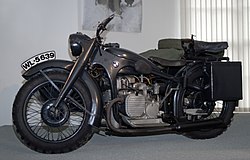BMW R12
 |
|
| Manufacturer | BMW |
|---|---|
| Production | 1935-1942 |
| Assembly | Munich, Germany |
| Predecessor | R11 |
| Class | boxer |
| Engine | Two-cylinder boxer 745cm³ - 18 hp at 3400 rev / min (20 hp at 4000 rev / min in the version with two carburetors) |
| Bore / stroke | 78 mm |
| Compression ratio | 5.2: 1 |
| Top speed | 110 km (68 mi) - 120 km (75 mi) |
| Power | 18 hp (13 kW) |
| Ignition type | Magneto or battery ignition |
| Transmission | Manual |
| Tires | 3.50 x 19 |
| Dimensions |
L: 210 cm (83 in) W: 90 cm (35 in) H: 94 cm (37 in) |
| Fuel capacity | 14 litres |
| Fuel consumption | 3.5-4L (every 100km) |
| Related | R17 |
The BMW R12 is a pre-World War II motorcycle that was produced by the German company BMW. The motorbike was first presented and developed in 1935. A total of 36,000 motorcycles were built by 1942.
On 14 February 1935, BMW presented the R12 together with the BMW R17 on the German Automobile Exhibition in Berlin for the first time, being a direct successor to the BMW R11. This and the R17 were the first in the world being produced with hydraulically damped telescopic forks. By 1942, the total number of BMW R12 motorcycles manufactured was 36,000. For military purposes, the Einvergasermotor was only available for the R12.
The engine, designated M 56 S 6 or 212, was a twin-cylinder boxer configuration - four stroke with a flathead design. The BMW R12 with two carburetors used a battery and coil ignition, while R12s with a single carburetor used a magneto ignition, capable of working independently from the battery.
The BMW R12 had a four-speed manual gearbox, operated by a hand shift lever on the fuel tank's right side. Several detail variations were seen in production. In common with most BMW Motorcycles, final drive was via shaft, with the drive shaft on the right side of the motorcycle.
Front suspension used a telescopic fork, while the frame was rigid with an un-sprung rear end supporting the final drive and a sprung seat for the rider. The R12 used drum brakes front and rear. Many R12's were equipped with a sidecar attached to the motorcycle's right side.
One example of a surviving BMW R12 motorcycle can be found in the Museum of Military History in Vienna, still bearing its original camouflage.Many R12's remain in service with private collectors.
...
Wikipedia
